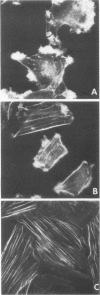Abstract
Treatment of Rous sarcoma virus-transformed rat cells with rat interferon-alpha (specific activity, 10(6) U/mg of protein) for 24 h caused a 50% reduction in intracellular pp60src-associated protein kinase activity. Staphylococcus aureus V8 protease digestion of pp60src, derived from 32P-labeled monolayer cultures incubated with or without interferon, revealed no differences either in the phosphopeptide pattern or in the phosphoserine-phosphotyrosine ratio. However, [3H]leucine pulse-labeling experiments showed that the synthesis of pp60src was reduced by 42 to 48%, relative to the level of bulk protein synthesis, in the interferon-treated cultures. Rat interferon-alpha also reduced the growth rate of Rous sarcoma virus-transformed rat cells in a dose-dependent manner over a 72-h period. The decrease in growth rate was accompanied by increases in the thickness and number of actin fibers per cell and by a decline in intracellular tyrosine phosphorylation by pp60src. The results suggest that interferon can inhibit the expression of the transformation-related phenotype by selectively reducing the synthesis of the Rous sarcoma virus transforming gene product. However, the interferon effects on the cytoskeletal organization and proliferation of Rous sarcoma virus-transformed cells may be due at least in part to the predominance of interferon-induced phenotypic changes over those caused by pp60src.
Full text
PDF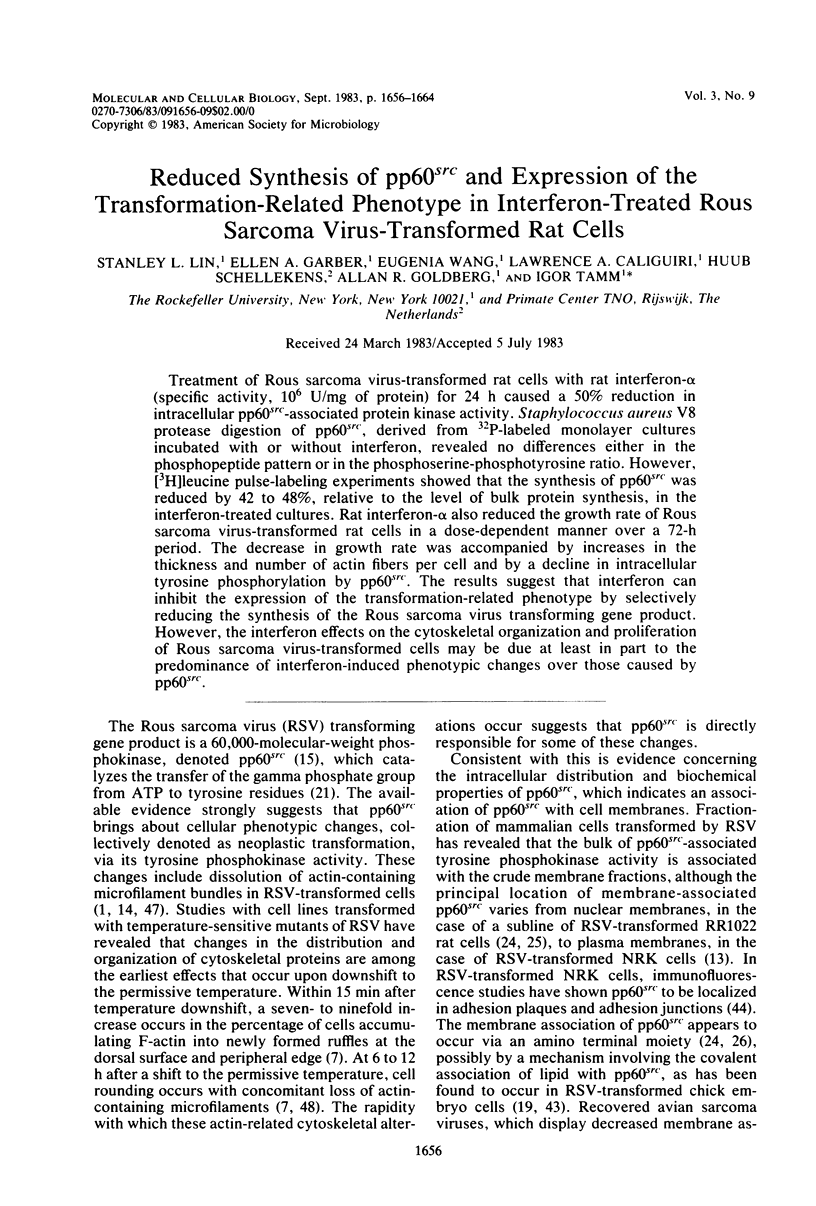
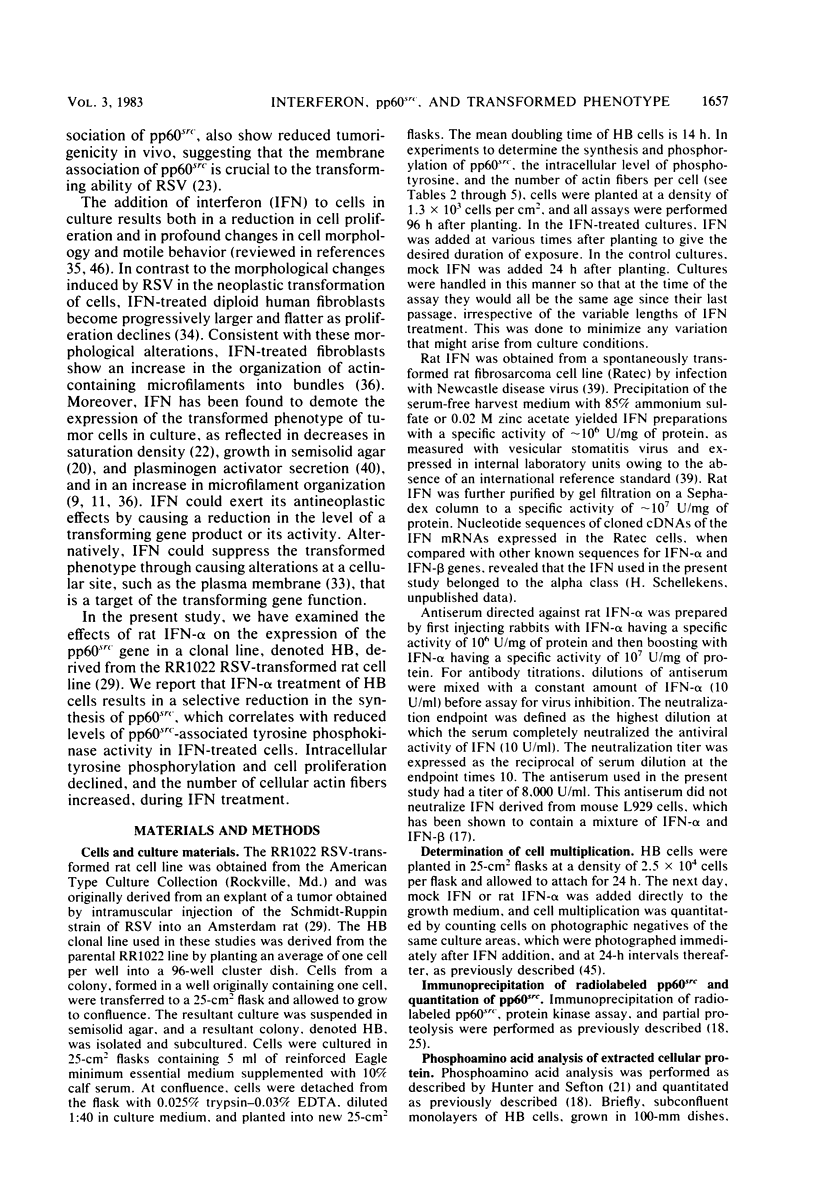
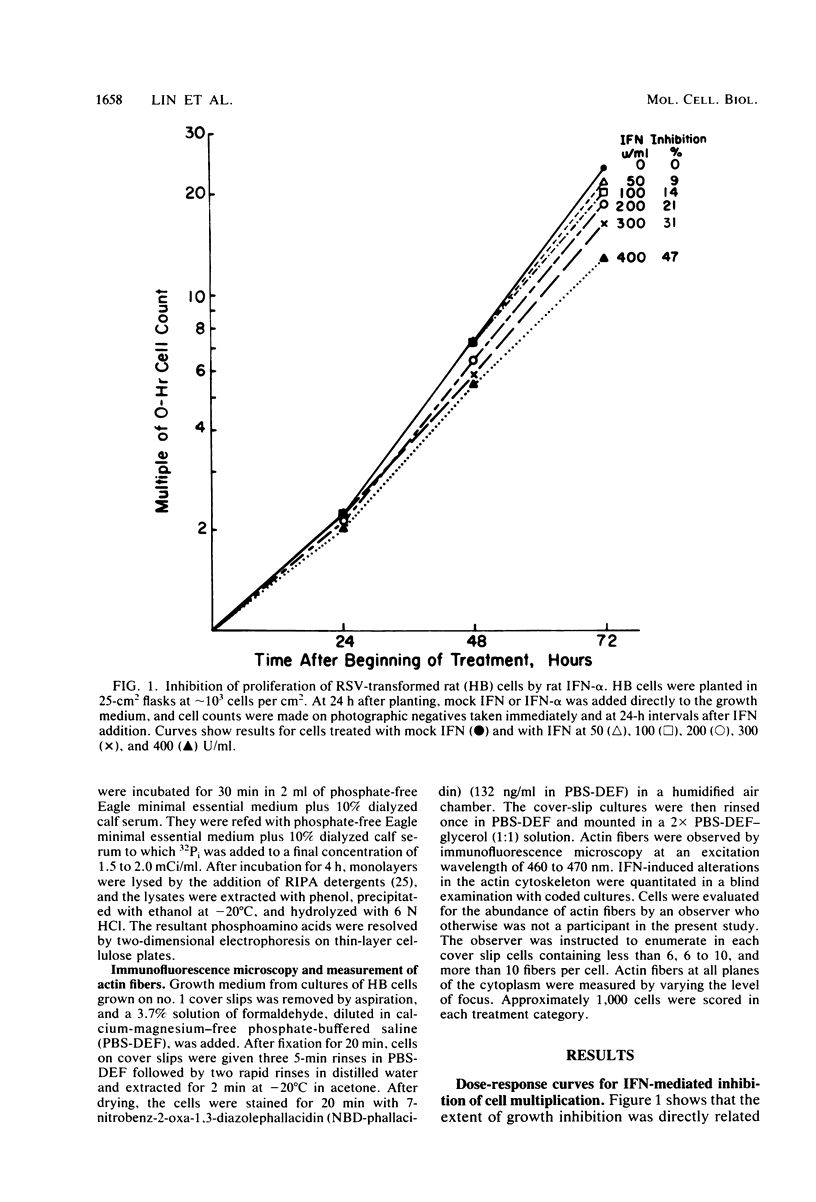
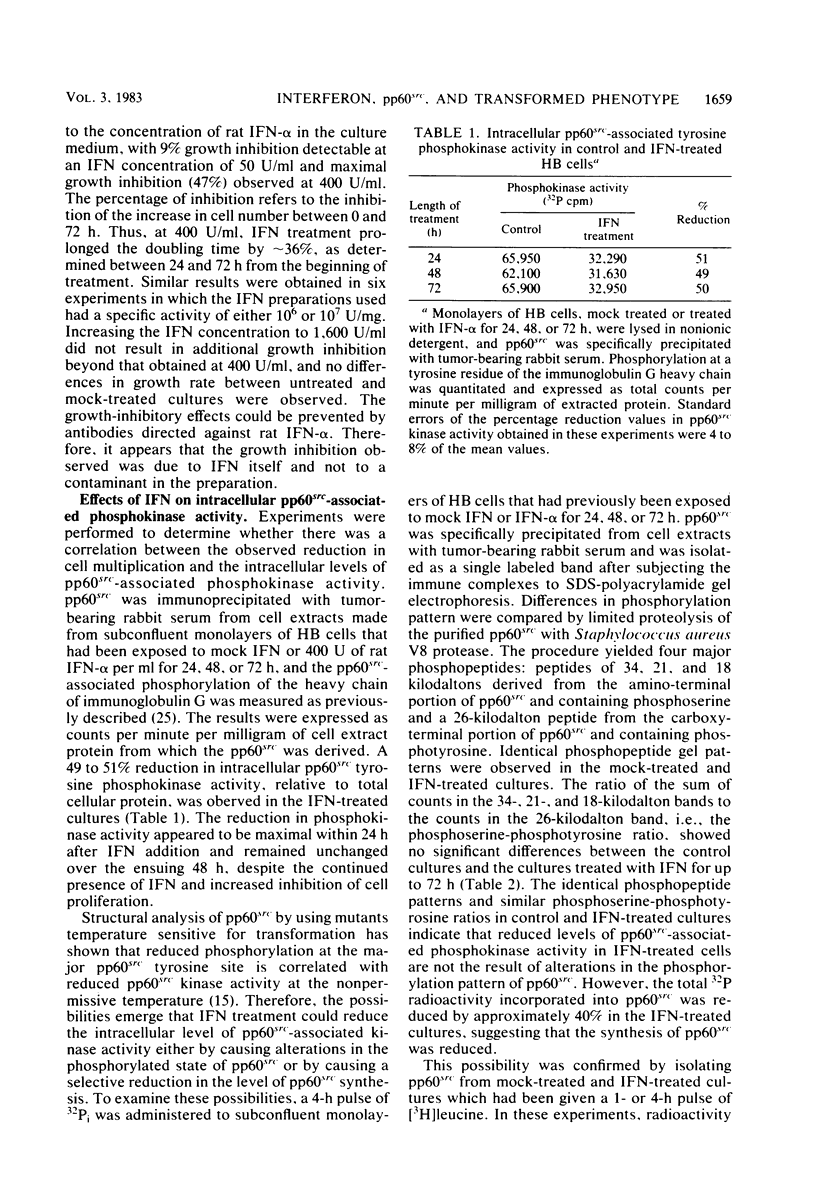
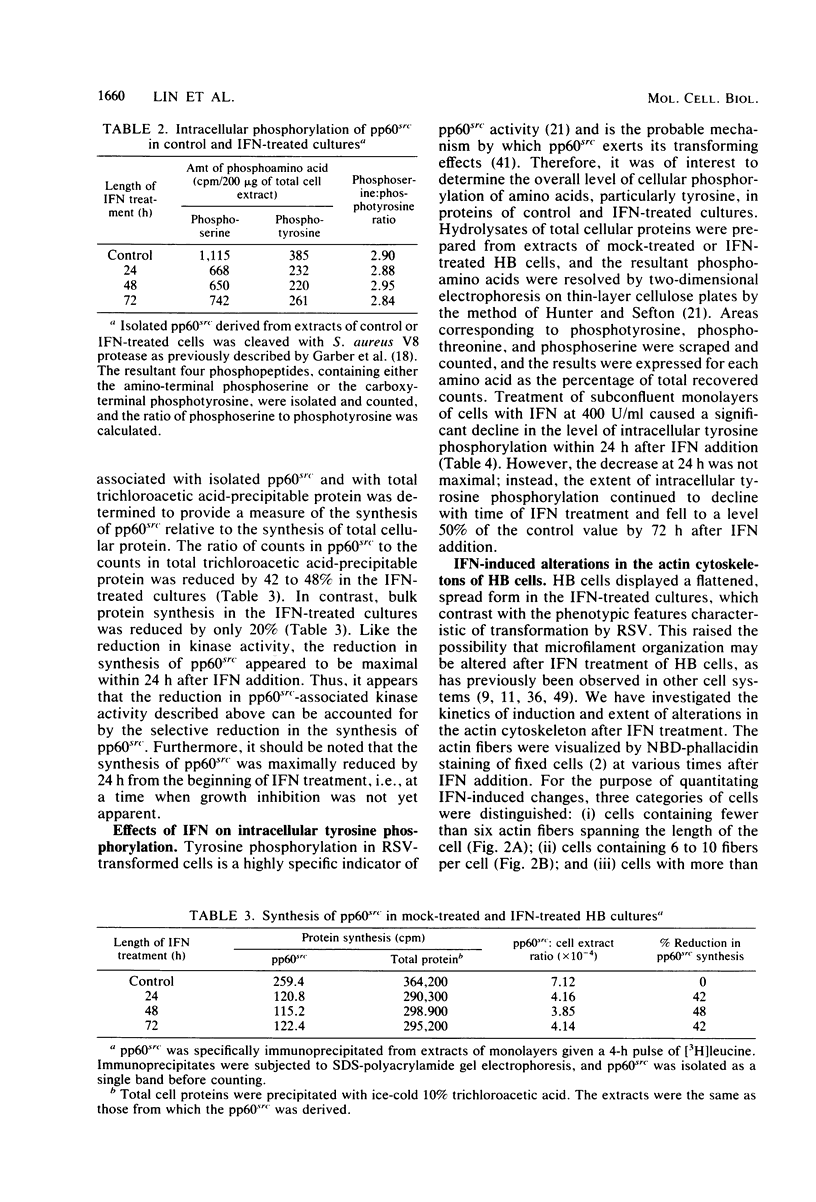
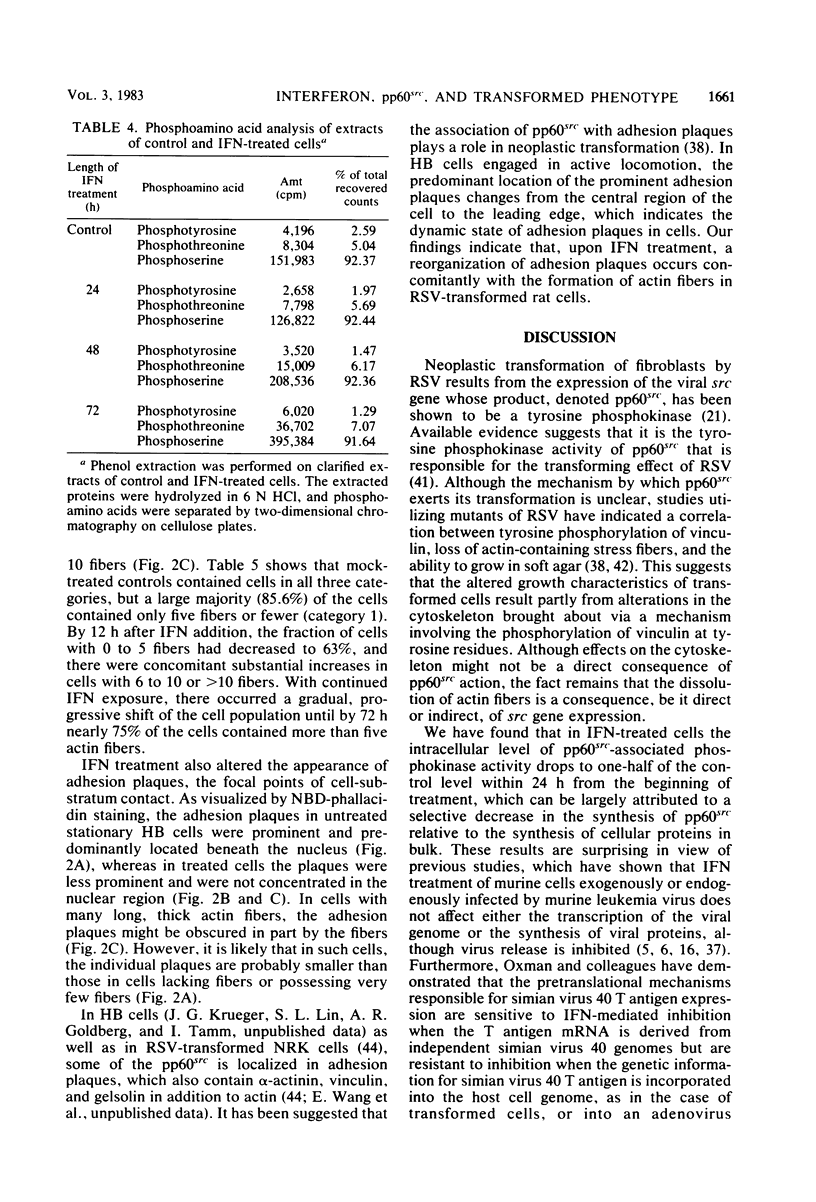
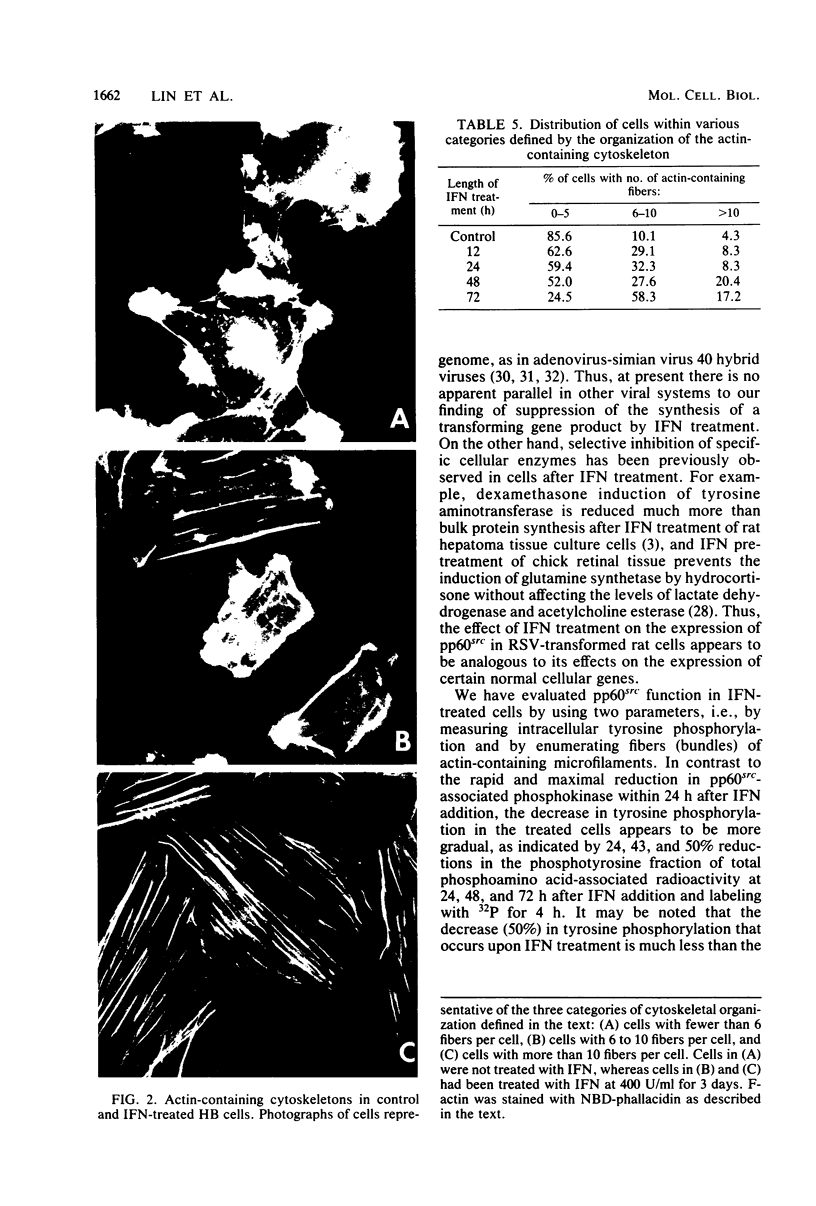

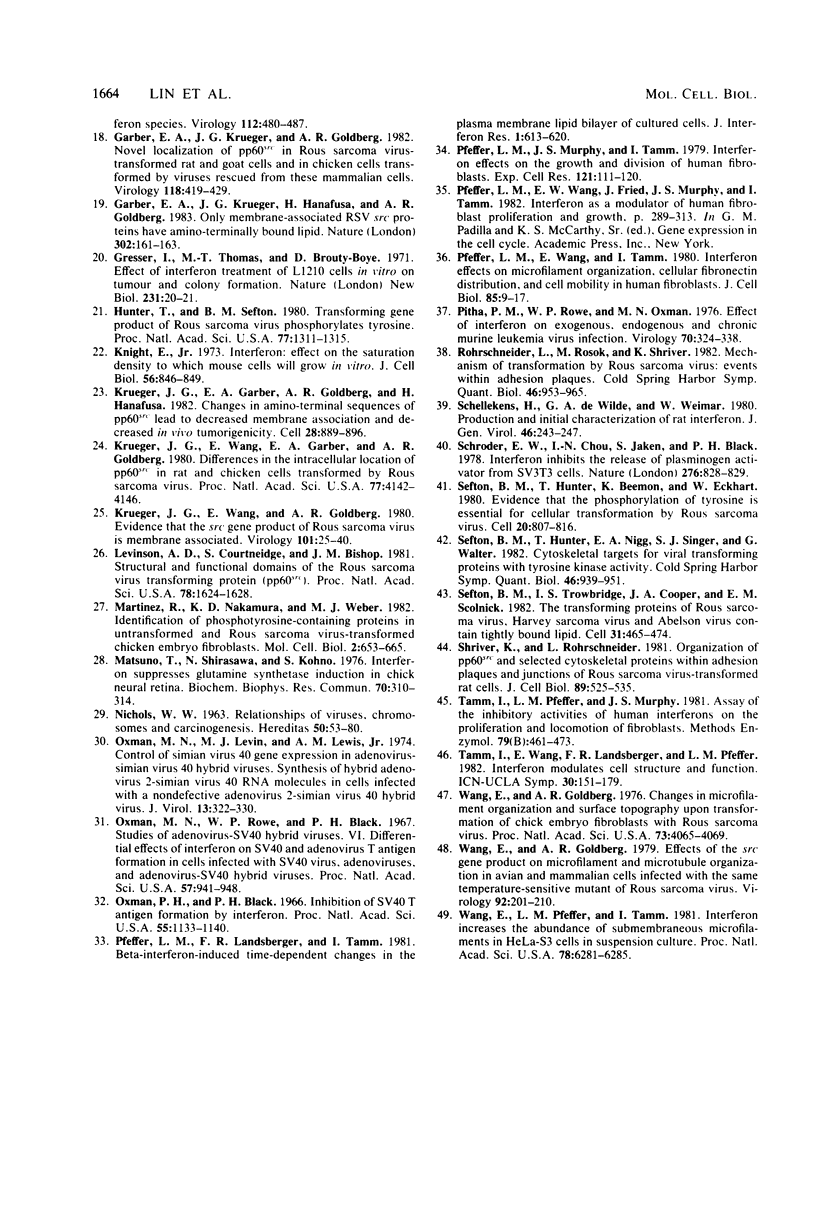
Images in this article
Selected References
These references are in PubMed. This may not be the complete list of references from this article.
- Ash J. F., Vogt P. K., Singer S. J. Reversion from transformed to normal phenotype by inhibition of protein synthesis in rat kidney cells infected with a temperature-sensitive mutant of Rous sarcoma virus. Proc Natl Acad Sci U S A. 1976 Oct;73(10):3603–3607. doi: 10.1073/pnas.73.10.3603. [DOI] [PMC free article] [PubMed] [Google Scholar]
- Barak L. S., Yocum R. R., Nothnagel E. A., Webb W. W. Fluorescence staining of the actin cytoskeleton in living cells with 7-nitrobenz-2-oxa-1,3-diazole-phallacidin. Proc Natl Acad Sci U S A. 1980 Feb;77(2):980–984. doi: 10.1073/pnas.77.2.980. [DOI] [PMC free article] [PubMed] [Google Scholar]
- Beck G., Poindron P., Illinger D., Beck J. P., Ebel J. P., Falcoff R. Inhibition of steroid inducible tyrosine aminotransferase by mouse and rat interferon in hepatoma tissue culture cells. FEBS Lett. 1974 Nov 15;48(2):297–300. doi: 10.1016/0014-5793(74)80490-4. [DOI] [PubMed] [Google Scholar]
- Beemon K., Ryden T., McNelly E. A. Transformation by avian sarcoma viruses leads to phosphorylation of multiple cellular proteins on tyrosine residues. J Virol. 1982 May;42(2):742–747. doi: 10.1128/jvi.42.2.742-747.1982. [DOI] [PMC free article] [PubMed] [Google Scholar]
- Billiau A., Edy V. G., Sobis H., de Somer P. Influence of interferon on virus-particle synthesis in oncornavirus-carrier lines. II. Evidence for a direct effect on particle release. Int J Cancer. 1974 Sep 15;14(3):335–340. doi: 10.1002/ijc.2910140306. [DOI] [PubMed] [Google Scholar]
- Billiau A., Heremans H., Allen P. T., De Maeyer-Guignard J., De Somer P. Trapping of oncornavirus particles at the surface of interferon-treated cells. Virology. 1976 Sep;73(2):537–542. doi: 10.1016/0042-6822(76)90416-5. [DOI] [PubMed] [Google Scholar]
- Boschek C. B., Jockusch B. M., Friis R. R., Back R., Grundmann E., Bauer H. Early changes in the distribution and organization of microfilament proteins during cell transformation. Cell. 1981 Apr;24(1):175–184. doi: 10.1016/0092-8674(81)90513-4. [DOI] [PubMed] [Google Scholar]
- Bourgeade M. F., Besançon F., Thang M. N. Interferon affects intracellular calmodulin levels. Biochem Biophys Res Commun. 1983 Mar 16;111(2):430–437. doi: 10.1016/0006-291x(83)90324-8. [DOI] [PubMed] [Google Scholar]
- Brouty-Boyé D., Cheng Y. S., Chen L. B. Association of phenotypic reversion of transformed cells induced by interferon with morphological and biochemical changes in the cytoskeleton. Cancer Res. 1981 Oct;41(10):4174–4184. [PubMed] [Google Scholar]
- Chafouleas J. G., Bolton W. E., Hidaka H., Boyd A. E., 3rd, Means A. R. Calmodulin and the cell cycle: involvement in regulation of cell-cycle progression. Cell. 1982 Jan;28(1):41–50. doi: 10.1016/0092-8674(82)90373-7. [DOI] [PubMed] [Google Scholar]
- Chany C., Rousset S., Bourgeade M. F., Mathieu D., Grégoire A. Role of receptors and the cytoskeleton in reverse transformation and steroidogenesis induced by interferon. Ann N Y Acad Sci. 1980;350:254–265. doi: 10.1111/j.1749-6632.1980.tb20626.x. [DOI] [PubMed] [Google Scholar]
- Cooper J. A., Hunter T. Similarities and differences between the effects of epidermal growth factor and Rous sarcoma virus. J Cell Biol. 1981 Dec;91(3 Pt 1):878–883. doi: 10.1083/jcb.91.3.878. [DOI] [PMC free article] [PubMed] [Google Scholar]
- Courtneidge S. A., Levinson A. D., Bishop J. M. The protein encoded by the transforming gene of avian sarcoma virus (pp60src) and a homologous protein in normal cells (pp60proto-src) are associated with the plasma membrane. Proc Natl Acad Sci U S A. 1980 Jul;77(7):3783–3787. doi: 10.1073/pnas.77.7.3783. [DOI] [PMC free article] [PubMed] [Google Scholar]
- Edelman G. M., Yahara I. Temperature-sensitive changes in surface modulating assemblies of fibroblasts transformed by mutants of Rous sarcoma virus. Proc Natl Acad Sci U S A. 1976 Jun;73(6):2047–2051. doi: 10.1073/pnas.73.6.2047. [DOI] [PMC free article] [PubMed] [Google Scholar]
- Erikson R. L., Purchio A. F., Erikson E., Collett M. S., Brugge J. S. Molecular events in cells transformed by Rous Sarcoma virus. J Cell Biol. 1980 Nov;87(2 Pt 1):319–325. doi: 10.1083/jcb.87.2.319. [DOI] [PMC free article] [PubMed] [Google Scholar]
- Friedman R. M., Ramseur J. M. Inhibition of murine leukemia virus production in chronically infected AKR cells: a novel effect of interferon. Proc Natl Acad Sci U S A. 1974 Sep;71(9):3542–3544. doi: 10.1073/pnas.71.9.3542. [DOI] [PMC free article] [PubMed] [Google Scholar]
- Garber E. A., Krueger J. G., Goldberg A. R. Novel localization of pp60src in Rous sarcoma virus-transformed rat and goat cells and in chicken cells transformed by viruses rescued from these mammalian cells. Virology. 1982 Apr 30;118(2):419–429. doi: 10.1016/0042-6822(82)90361-0. [DOI] [PubMed] [Google Scholar]
- Garber E. A., Krueger J. G., Hanafusa H., Goldberg A. R. Only membrane-associated RSV src proteins have amino-terminally bound lipid. Nature. 1983 Mar 10;302(5904):161–163. doi: 10.1038/302161a0. [DOI] [PubMed] [Google Scholar]
- Gresser I., Thomas M. T., Brouty-Boyé D. Effect of interferon treatment of L1210 cells in vitro on tumour and colony formation. Nat New Biol. 1971 May 5;231(18):20–21. [PubMed] [Google Scholar]
- Hunter T., Sefton B. M. Transforming gene product of Rous sarcoma virus phosphorylates tyrosine. Proc Natl Acad Sci U S A. 1980 Mar;77(3):1311–1315. doi: 10.1073/pnas.77.3.1311. [DOI] [PMC free article] [PubMed] [Google Scholar]
- Knight E., Jr Interferon: effect on the saturation density to which mouse cells will grow in vitro. J Cell Biol. 1973 Mar;56(3):846–849. doi: 10.1083/jcb.56.3.846. [DOI] [PMC free article] [PubMed] [Google Scholar]
- Krueger J. G., Garber E. A., Goldberg A. R., Hanafusa H. Changes in amino-terminal sequences of pp60src lead to decreased membrane association and decreased in vivo tumorigenicity. Cell. 1982 Apr;28(4):889–896. doi: 10.1016/0092-8674(82)90068-x. [DOI] [PubMed] [Google Scholar]
- Krueger J. G., Wang E., Garber E. A., Goldberg A. R. Differences in intracellular location of pp60src in rat and chicken cells transformed by Rous sarcoma virus. Proc Natl Acad Sci U S A. 1980 Jul;77(7):4142–4146. doi: 10.1073/pnas.77.7.4142. [DOI] [PMC free article] [PubMed] [Google Scholar]
- Krueger J. G., Wang E., Goldberg A. R. Evidence that the src gene product of Rous sarcoma virus is membrane associated. Virology. 1980 Feb;101(1):25–40. doi: 10.1016/0042-6822(80)90480-8. [DOI] [PubMed] [Google Scholar]
- Levinson A. D., Courtneidge S. A., Bishop J. M. Structural and functional domains of the Rous sarcoma virus transforming protein (pp60src). Proc Natl Acad Sci U S A. 1981 Mar;78(3):1624–1628. doi: 10.1073/pnas.78.3.1624. [DOI] [PMC free article] [PubMed] [Google Scholar]
- Martinez R., Nakamura K. D., Weber M. J. Identification of phosphotyrosine-containing proteins in untransformed and Rous sarcoma virus-transformed chicken embryo fibroblasts. Mol Cell Biol. 1982 Jun;2(6):653–665. doi: 10.1128/mcb.2.6.653. [DOI] [PMC free article] [PubMed] [Google Scholar]
- Matsuno T., Shirasawa N., Kohno S. Interferon suppresses glutamine synthetase induction in chick embryonic neural retina. Biochem Biophys Res Commun. 1976 May 3;70(1):310–314. doi: 10.1016/0006-291x(76)91143-8. [DOI] [PubMed] [Google Scholar]
- Oxman M. N., Black P. H. Inhibition of SV40 T antigen formation by interferon. Proc Natl Acad Sci U S A. 1966 May;55(5):1133–1140. doi: 10.1073/pnas.55.5.1133. [DOI] [PMC free article] [PubMed] [Google Scholar]
- Oxman M. N., Levin M. J., Lewis A. M., Jr Control of simian virus 40 gene expression in adenovirus-simian virus 40 hybrid viruses. Synthesis of hybrid adenovirus 2-simian virus 40 RNA molecules in cells infected with a nondefective adenovirus 2-simian virus 40 hybrid virus. J Virol. 1974 Feb;13(2):322–330. doi: 10.1128/jvi.13.2.322-330.1974. [DOI] [PMC free article] [PubMed] [Google Scholar]
- Oxman M. N., Rowe W. P., Black P. H. Studies of adenovirus-SV40 hybrid viruses, VI. Differential effects of interferon on SV40 and adenovirus T antigen formation in cells infected with SV40 virus, adenoviruses, and adenovirus-SV40 hybrid viruses. Proc Natl Acad Sci U S A. 1967 Apr;57(4):941–948. doi: 10.1073/pnas.57.4.941. [DOI] [PMC free article] [PubMed] [Google Scholar]
- Pfeffer L. M., Landsberger F. R., Tamm I. Beta-interferon-induced time-dependent changes in the plasma membrane lipid bilayer of cultured cells. J Interferon Res. 1981;1(4):613–620. doi: 10.1089/jir.1981.1.613. [DOI] [PubMed] [Google Scholar]
- Pfeffer L. M., Murphy J. S., Tamm I. Interferon effects on the growth and division of human fibroblasts. Exp Cell Res. 1979 Jun;121(1):111–120. doi: 10.1016/0014-4827(79)90450-6. [DOI] [PubMed] [Google Scholar]
- Pfeffer L. M., Wang E., Landsberger F. R., Tamm I. Assays to measure plasma membrane and cytoskeletal changes in interferon-treated cells. Methods Enzymol. 1981;79(Pt B):461–473. doi: 10.1016/s0076-6879(81)79060-8. [DOI] [PubMed] [Google Scholar]
- Pfeffer L. M., Wang E., Tamm I. Interferon effects on microfilament organization, cellular fibronectin distribution, and cell motility in human fibroblasts. J Cell Biol. 1980 Apr;85(1):9–17. doi: 10.1083/jcb.85.1.9. [DOI] [PMC free article] [PubMed] [Google Scholar]
- Pitha P. M., Rowe W. P., Oxman M. N. Effect of interferon on exogenous, endogenous, and chroniv murine leukemia virus infection. Virology. 1976 Apr;70(2):324–338. doi: 10.1016/0042-6822(76)90275-0. [DOI] [PubMed] [Google Scholar]
- Rohrschneider L., Rosok M., Shriver K. Mechanism of transformation by Rous sarcoma virus: events within adhesion plaques. Cold Spring Harb Symp Quant Biol. 1982;46(Pt 2):953–965. doi: 10.1101/sqb.1982.046.01.089. [DOI] [PubMed] [Google Scholar]
- Schellekens H., De Wilde G. A., Weimar W. Production and initial characterization of rat interferon. J Gen Virol. 1980 Jan;46(1):243–247. doi: 10.1099/0022-1317-46-1-243. [DOI] [PubMed] [Google Scholar]
- Schroder E. W., Chou I. N., Jaken S., Black P. H. Interferon inhibits the release of plasminogen activator from SV3T3 cells. Nature. 1978 Dec 21;276(5690):828–829. doi: 10.1038/276828a0. [DOI] [PubMed] [Google Scholar]
- Sefton B. M., Hunter T., Beemon K., Eckhart W. Evidence that the phosphorylation of tyrosine is essential for cellular transformation by Rous sarcoma virus. Cell. 1980 Jul;20(3):807–816. doi: 10.1016/0092-8674(80)90327-x. [DOI] [PubMed] [Google Scholar]
- Sefton B. M., Hunter T., Nigg E. A., Singer S. J., Walter G. Cytoskeletal targets for viral transforming proteins with tyrosine protein kinase activity. Cold Spring Harb Symp Quant Biol. 1982;46(Pt 2):939–951. doi: 10.1101/sqb.1982.046.01.088. [DOI] [PubMed] [Google Scholar]
- Sefton B. M., Trowbridge I. S., Cooper J. A., Scolnick E. M. The transforming proteins of Rous sarcoma virus, Harvey sarcoma virus and Abelson virus contain tightly bound lipid. Cell. 1982 Dec;31(2 Pt 1):465–474. doi: 10.1016/0092-8674(82)90139-8. [DOI] [PubMed] [Google Scholar]
- Shriver K., Rohrschneider L. Organization of pp60src and selected cytoskeletal proteins within adhesion plaques and junctions of Rous sarcoma virus-transformed rat cells. J Cell Biol. 1981 Jun;89(3):525–535. doi: 10.1083/jcb.89.3.525. [DOI] [PMC free article] [PubMed] [Google Scholar]
- Wang E., Goldberg A. R. Changes in microfilament organization and surface topogrophy upon transformation of chick embryo fibroblasts with Rous sarcoma virus. Proc Natl Acad Sci U S A. 1976 Nov;73(11):4065–4069. doi: 10.1073/pnas.73.11.4065. [DOI] [PMC free article] [PubMed] [Google Scholar]
- Wang E., Goldberg A. R. Effects of the src gene product on microfilament and microtubule organization in avian and mammalian cells infected with the same temperature-sensitive mutant of Rous sarcoma virus. Virology. 1979 Jan 15;92(1):201–210. doi: 10.1016/0042-6822(79)90225-3. [DOI] [PubMed] [Google Scholar]
- Wang E., Pfeffer L. M., Tamm I. Interferon increases the abundance of submembranous microfilaments in HeLa-S3 cells in suspension culture. Proc Natl Acad Sci U S A. 1981 Oct;78(10):6281–6285. doi: 10.1073/pnas.78.10.6281. [DOI] [PMC free article] [PubMed] [Google Scholar]



